Infantigo
What Is Infantigo?
Infantigo is known in other names as impetigo or pyoderma. It is a devastating skin disease, which can affect both adults and children. Infantigo ruins the flesh and can leave a lot of emotional and psychological damage to the affected people. The symptoms of this skin disease are recurring and you will find that people with the disorder are caged in a frustrating cycle of remissions. 1,2,3,4,5
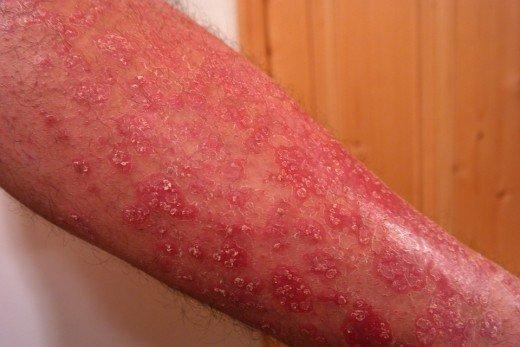
Affected people may suffer from social stigma and the worst thing is that the disorder is regarded as highly contagious. While infantigo affects adults, it is seen more in children aged two to five years. The disease may spread from an individual to another and from one body area to another.
If an person with the disorder scratches their skin, the causal bacteria can be carried underneath the nails and begin to spread in the fingers . On touching another person or another part of the body, the bacteria will spread.
Signs and Symptoms
People with infantigo will show signs and symptoms that may vary depending on the type of bacteria causing the disorder and the type of infantigo. 1,2
- Initial signs include reddening of the affected skin and itching
- The red, itchy skin areas may spread and grow bigger
- The blisters may appear the size of a pimple and could grow bigger to form patches the size of a quarter coin
- The blisters may appear anywhere on the body including the arms and legs, but they tend to be seen on the face, particularly the areas around the nose and mouth
- The blisters erupt and start oozing pus after sometime
- The pus dries up to form thick, honey-colored crust
- After the crusts go away, red marks are left behind but upon treatment, the red marks tend to disappear and an individual may be left with no scars
- Usually the blisters arising from infantigo aren’t painful, but they are very itchy and this makes a person or a child to stay awake at night.
Types of Infantigo
There are three main types of infantigo and they include:
Non-bullous impetigo
It is also known as impetigo contagiosa and it the commonest type of this skin disorder. It occurs in about 70 percent of all incidents of the infantigo. Impentigo contagiosa starts with patches of red skin forming around the nasal and oral skin areas. Usually, rashes will appear in about 4 to 10 days following the infection.
Blisters will form but they are not always noticeable because they tend to erupt quickly thus leaving clusters consisting of yellow pus. The clusters of yellow pus dry up forming crusty surface, which is a characteristic associated with this disorder. The crusts fall off and the skin becomes hyper-pigmented for a period of about 6 months.
Non-bullous impentigo can be very itchy and affected individuals may cause skin injury when they scratch the infected blisters. The patches of impentigo contagiosa unlike those of bullous impetigo tend to be small- about a centimeter or so in size. Non-bullous impetigo may be caused by Streptococcus pyogenes or Staphylococcus aureus type of bacteria.
Bullous impetigo
A less common type of the skin disorder, bullous impetigo occurs in babies of less than two years old and in infants. With this type of infantigo, it tends to begin in extremities and at other times, it may start off all over the torso. The blisters may form on the bottom of an infant often being mistaken for a diaper rash. The rashes may be seen in other areas such as the groin, neck, and axilla. The size of the blisters may be about 5mm or more and are surrounded by a reddish skin. These blisters spread quickly and the skin appearing on top becomes flimsy and falls off easily.
When the blisters peel off, they expose big, red, raw patches on the skin. Like non-bullous impentigo, the bullous infantigo have a yellowish crust forming on the skin after the blisters erupt. The crust heal and leave no scarring or discoloration. The blisters are itchy but not painful.
A child suffering from bullous impentigo may have other symptoms like fever or swelling of glands. In some toddlers and infants, they may have diarrhea. Bullous impentigo is specifically caused by Staphylococcus aureus. This bacteria strain releases a toxin (exfoliative toxin A) and this substance attacks the skin layer.
In severe cases of bullous impentigo, it may cause the epidermis, which is the outer layer of the skin to separate from the dermis, which is the inner layer of a person’s skin. The separation of epidermis and dermis is called staphylococcal scalded skin syndrome (SSSS). The syndrome is characterized by peeling and cracking of the skin around a patient’s mouth. Upon peeling, the skin may appear like burns.
Ecthyma
It’s a rare type of infantigo and usually more severe than the others. It tends to penetrate deep into the patient’s tissue. Ecthyma is also known as ulcerative impentigo. The disorder causes ulcers on the skin or some deep level of skin erosions that extend to the dermis.
Ecthyma tends to affect lower extremities including the thighs, legs, ankles, and feet. The blisters may also be seen on buttocks. A person with the disorder may have other symptoms like painful, swollen lymph nodes. Usually the lesions occurring due to this disorder start off as vesicles. The patient has small blisters, which look like those of chickenpox. The blisters will grow and with time, they form hardened crusts on the lesions.
Usually, the crusts appear thick and tend to be difficult to scrape them off. If the crusts are removed, there will be an indurated ulcer that is exposed. This ulcer looks red in color and is inflamed. The ulcer releases pus. Ecthyma, unlike the other forms of infantigo, leaves permanent scars on skin. Ecthyma is caused by a group of bacteria known as A beta-hemolytic streptococci, but it may also be caused by other strains of bacteria like straph.
Causes of Infantigo
The causative agent for infantigo is a bacterial infection. It is the only one cause that has been known to bring about the skin disorder. The strains of bacteria that cause infantigo are:
- Staphylococcus aureus
- Streptococcus pyogenes
However, there are factors which make a person to have increased chances of having the infection and they include having cuts, broken skin, and scratches. If you have a rash such as eczema or poison ivy rashes, and other ailments that irritate your skin, you may be susceptible to the disorder. People with allergies to things that cause inflammation of skin may also be at risk of getting the infection.
Having physical contact with a person infected with the causative bacteria can make you vulnerable to the disease. If you share contaminated clothing, toys, towels, bedding, and other personal items, you could be at increased risk of being infected with the bacteria. Insect bites may also make you vulnerable.1,2,3,4,5
An infection can start in two ways:
- Primary impetigo starts when bacteria invade an individual’s skin through insect bites, a cut, or a lesion forming on normal skin of the person
- Secondary impentigo starts when bacteria invade the individual’s skin because there is another skin infection or ailment, which disrupts the protective role of the skin such as scabies and eczema.
Diagnosis of Infantigo
It’s quite easy to diagnose a person of infantigo disorder. The doctor will use the following procedure to determine if it is a case of infantigo or not:
Physical exam
The doctor checks the affected area and may ask questions. For instance, a doctor may want to know if a patient had recent scrapes, cuts, or insect bites occurring on the affected area. The doctor may want to find out if infantigo is appearing on an area that has another skin condition like eczema or scabies.
Swab Test
A doctor may take samples of the skin where crusts or blisters have formed using a swab to help determine, which germs are causing the condition. This helps determine the correct antibiotic to use in treatment. The swab test may also help determine if there could be another infection present for example shingles or ringworms. The doctor may also take a swab from a patient’s nose if he or she has been having recurring incidents of infantigo to help establish if the causative agent or bacteria may be residing there.
Usually, further tests after a physical exam are ordered if a patient has severe symptoms, which are spreading to other parts, or if the patient is not responding to treatment. The tests may also be ordered if the infection is recurring. 4
Treatment of Infantigo
In treating infantigo, doctors aim to speed up the healing and try to improve the appearance of skin. The treatment also helps prevent complications that may occur and the spreading of the infection. The treatment offered will depend on which type of infantigo a patient has and the extend of symptoms.
- For mild infections, a doctor may consider taking hygienic measures to ensure the skin is clean
- Topical antibiotics may be used to treat an infection on the skin. The antibiotic is applied onto the skin. The medication may include Bactroban or mupirocin ointment. Before a patient applies the antibiotics, they may want to remove the scabs or crusts to allow the medication to penetrate deep into the skin.
- Oral antibiotic is recommended if the disease has spread to other many parts of body or if topical antibiotics are ineffective. The antibiotic course lasts for about 7 days and it is critical that a patient completes the course of the dose even when symptoms have subsided.
- Wash the patient’s towels, clothes, and bed lines daily and these items should be separated from those of other people.
- Regularly wash your hands using antibacterial soap and warm water
- Use garlic because it has powerful antibacterial compound known as allicin which helps fight the infection. It’s also a great detoxifying agent. A patient can take about three cloves of garlic in raw form every day when they have infantigo. You can use the garlic alongside sesame oil to prepare a mixture that you can apply on the affected skin two times a day.
- Use white vinegar, which also has potent antibacterial properties. Combining a tablespoonful of vinegar together with some warm water and applying onto the affected skin helps fight the bacteria.
- You may use tea tree oil to treat mild infection of infantigo. Tea tree oil is recommended if the lesions are occurring on the face. You can use the tea tree oil alongside olive oil to apply onto the skin.
- Echinacea is a herb that helps enhance the immune system. It thus helps prevent complications that come with infantigo. Echinacea has phytochemicals, which are important in immune system. This herb not only helps combat bacteria, but also speeds up the recovery of a patient’s broken skin. Echinacea can be taken as tea though you can also use cooled echinacea tea as a compress.
- Other helpful products include ginger and turmeric, olive oil, grape fruit seed extract, goosegrass, aloe Vera, or Manuka honey. 1,2,3,4,5
Pictures
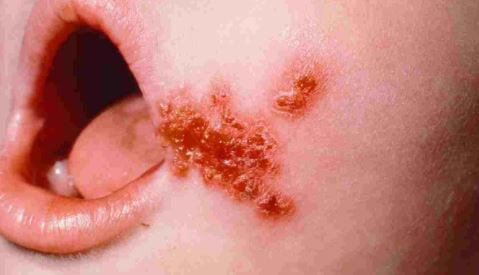
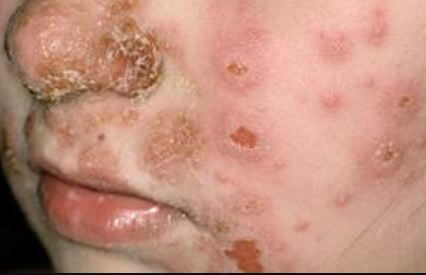
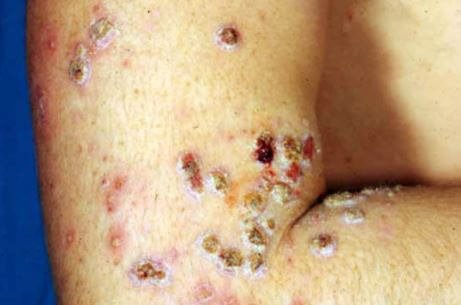
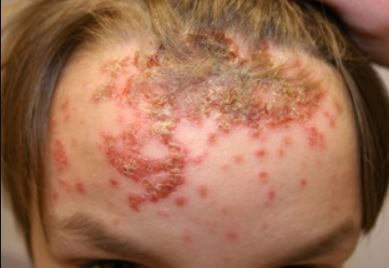
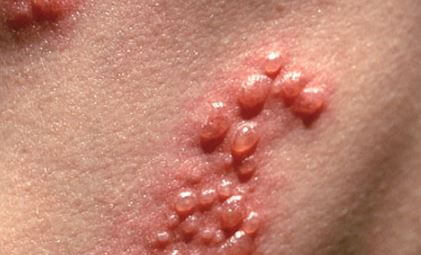

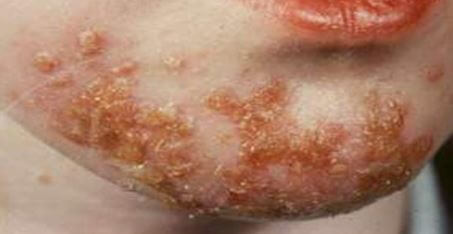

Reference List
- Impetigo (Infantigo): Symptoms, Causes, and Treatments. Available at https://healdove.com/
- What Is Infantigo (Impetigo)? Symptoms, Causes, and Treatments for Infantigo. Available at http://www.doctorshealthpress.com/
- Impetigo – Topic Overview. Available at http://www.webmd.com/skin-problems-and-treatments/tc/impetigo-overview#1
- Impetigo: Causes, Symptoms, and Treatments. Available at http://www.medicalnewstoday.com/articles/162945.php
- Infantigo – Pictures, Contagious, Causes, Symptoms, Treatment. Available at http://www.infantigo.xyz/
